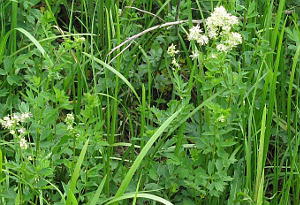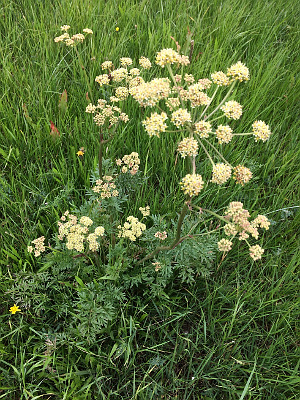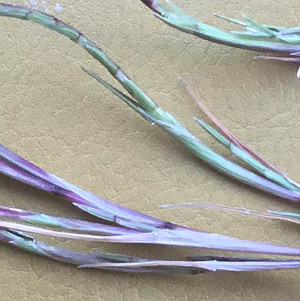Beta vulgaris ssp. cicla var. flavescens escaped in Withernsea
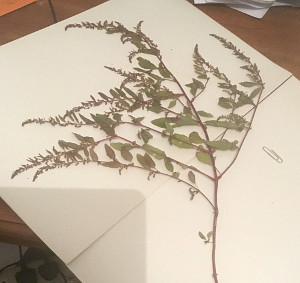 I rarely get excited about garden escapes but one deserving some of my time to ascribe a name was found on a scruffy grass verge in Withernsea. It was growing through a tangle of knotgrass together with various plantains. Being in the wrong place it was sacrificed for investigative botany.
I rarely get excited about garden escapes but one deserving some of my time to ascribe a name was found on a scruffy grass verge in Withernsea. It was growing through a tangle of knotgrass together with various plantains. Being in the wrong place it was sacrificed for investigative botany.
The arrangement of floral elements places it in the Genus Beta, species vulgaris, the absence of a swollen root places it in ssp. cicla, and the rich colouration (shocking pink through carmine to blood red) with succulent, deeply grooved petioles indicates var. flavescens. This is the fodder beet cultivar, Swiss Chard. There are no basal leaves and the whole plant (see photo) is attenuated, depauperate and has run to seed.
It is now stuck to a sheet of paper as a voucher specimen should this be ever considered recordable.
Peter J Cook, 9 October 2020
Hull City Council’s "wild" flowers
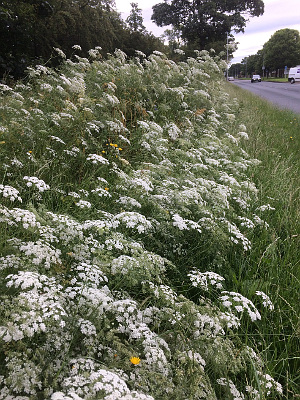 A considerable length of Bude Road verge in Kingswood has been sown with a colourful mixture including Cornflower (pink and blue forms) and various colours and species of poppy. These are beginning to fade, and the mix is now dominated by drifts of a white umbellifer with finely-divided grey-green foliage and conspicuous bracts, from a distance resembling an exceptionally tall Wild Carrot. However the plant, unlike Wild Carrot, is completely hairless, and has 1-pinnate basal leaves recalling Pimpinella spp. It appears to be the southern european species Ammi majus, whose english name of Bullwort seems inappropriate for such a graceful plant. It has been recorded occasionally in the past as a garden escape, and if this manages to set seed we could be seeing more of it in the area.
A considerable length of Bude Road verge in Kingswood has been sown with a colourful mixture including Cornflower (pink and blue forms) and various colours and species of poppy. These are beginning to fade, and the mix is now dominated by drifts of a white umbellifer with finely-divided grey-green foliage and conspicuous bracts, from a distance resembling an exceptionally tall Wild Carrot. However the plant, unlike Wild Carrot, is completely hairless, and has 1-pinnate basal leaves recalling Pimpinella spp. It appears to be the southern european species Ammi majus, whose english name of Bullwort seems inappropriate for such a graceful plant. It has been recorded occasionally in the past as a garden escape, and if this manages to set seed we could be seeing more of it in the area.
Rohan Lewis, 21 July 2020
Sand Leek (Allium scorodoprasum) re-found in the Wolds
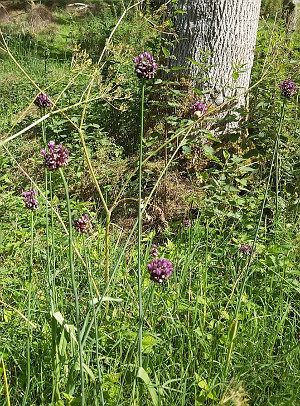 Penny Darmody from Cottingham spotted this striking plant while out running in Hunsley Dale (SE9434), and with help from the BSBI website was able to identify it and contact me.Visiting the site, I found a patch of about 20 plants is in a fairly wooded dale, growing among nettles and tall false-oat grass. The ash trees among which it grows have been been affected by dieback, which might work to the advantage of this plant, normally found in open grassland.
Penny Darmody from Cottingham spotted this striking plant while out running in Hunsley Dale (SE9434), and with help from the BSBI website was able to identify it and contact me.Visiting the site, I found a patch of about 20 plants is in a fairly wooded dale, growing among nettles and tall false-oat grass. The ash trees among which it grows have been been affected by dieback, which might work to the advantage of this plant, normally found in open grassland.
This is only the fourth record for vc61 this century. The site is not far from the junction with East Dale, now densely wooded, but where the plant was recorded by Eva Crackles in 1966.
Rohan Lewis, 20 July 2020
photo - Penny Darmody
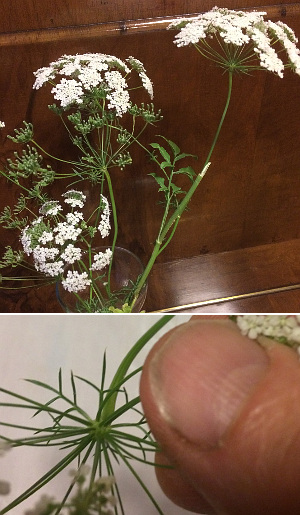
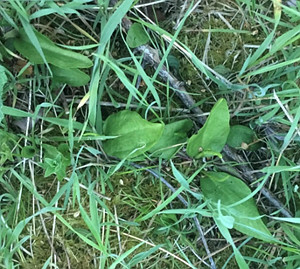 On 16 May I spotted numerous Ophioglossum vulgatum plants in the dappled shade of an Ash plantation within the Hollym Carrs Nature Reserve at TA327245. A second visit made on 25 May, to make notes of habitat and take photographs, was rewarded with the discovery that I had previously located only a small part of a colony occupying an elliptical area about 35 m x 4 m.
On 16 May I spotted numerous Ophioglossum vulgatum plants in the dappled shade of an Ash plantation within the Hollym Carrs Nature Reserve at TA327245. A second visit made on 25 May, to make notes of habitat and take photographs, was rewarded with the discovery that I had previously located only a small part of a colony occupying an elliptical area about 35 m x 4 m. 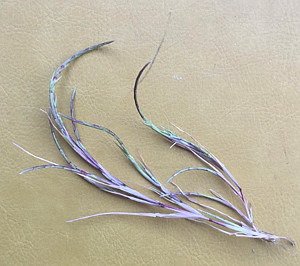
 I rarely get excited about garden escapes but one deserving some of my time to ascribe a name was found on a scruffy grass verge in Withernsea. It was growing through a tangle of knotgrass together with various plantains. Being in the wrong place it was sacrificed for investigative botany.
I rarely get excited about garden escapes but one deserving some of my time to ascribe a name was found on a scruffy grass verge in Withernsea. It was growing through a tangle of knotgrass together with various plantains. Being in the wrong place it was sacrificed for investigative botany. A considerable length of Bude Road verge in Kingswood has been sown with a colourful mixture including Cornflower (pink and blue forms) and various colours and species of poppy. These are beginning to fade, and the mix is now dominated by drifts of a white umbellifer with finely-divided grey-green foliage and conspicuous bracts, from a distance resembling an exceptionally tall Wild Carrot. However the plant, unlike Wild Carrot, is completely hairless, and has 1-pinnate basal leaves recalling Pimpinella spp. It appears to be the southern european species Ammi majus, whose english name of Bullwort seems inappropriate for such a graceful plant. It has been recorded occasionally in the past as a garden escape, and if this manages to set seed we could be seeing more of it in the area.
A considerable length of Bude Road verge in Kingswood has been sown with a colourful mixture including Cornflower (pink and blue forms) and various colours and species of poppy. These are beginning to fade, and the mix is now dominated by drifts of a white umbellifer with finely-divided grey-green foliage and conspicuous bracts, from a distance resembling an exceptionally tall Wild Carrot. However the plant, unlike Wild Carrot, is completely hairless, and has 1-pinnate basal leaves recalling Pimpinella spp. It appears to be the southern european species Ammi majus, whose english name of Bullwort seems inappropriate for such a graceful plant. It has been recorded occasionally in the past as a garden escape, and if this manages to set seed we could be seeing more of it in the area.
 Penny Darmody from Cottingham spotted this striking plant while out running in Hunsley Dale (SE9434), and with help from the BSBI website was able to identify it and contact me.Visiting the site, I found a patch of about 20 plants is in a fairly wooded dale, growing among nettles and tall false-oat grass. The ash trees among which it grows have been been affected by dieback, which might work to the advantage of this plant, normally found in open grassland.
Penny Darmody from Cottingham spotted this striking plant while out running in Hunsley Dale (SE9434), and with help from the BSBI website was able to identify it and contact me.Visiting the site, I found a patch of about 20 plants is in a fairly wooded dale, growing among nettles and tall false-oat grass. The ash trees among which it grows have been been affected by dieback, which might work to the advantage of this plant, normally found in open grassland.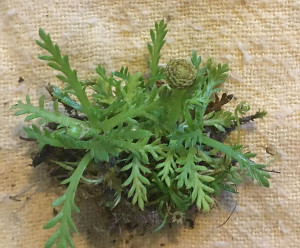 While botanizing in the North Yorkshire Moors National Park on 19 July I pulled off the road onto a parking area West of Egton Bridge at NGR
While botanizing in the North Yorkshire Moors National Park on 19 July I pulled off the road onto a parking area West of Egton Bridge at NGR 